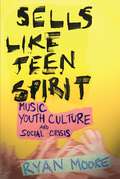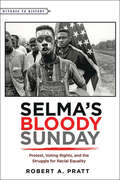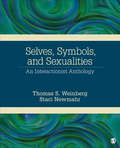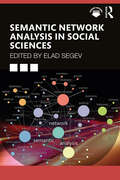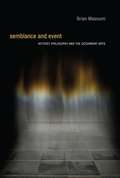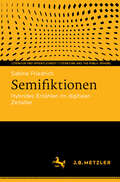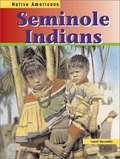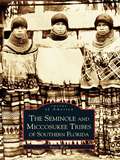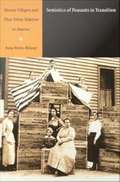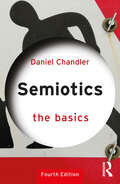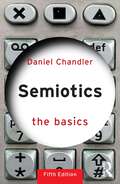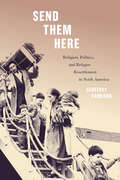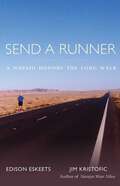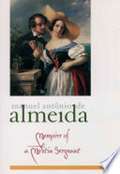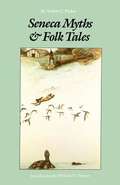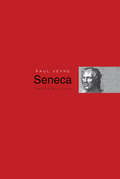- Table View
- List View
Sells like Teen Spirit: Music, Youth Culture, and Social Crisis
by Ryan MooreThis account of modern rock music &“skillfully articulates the brutal social truths that compel young people to create meaning and subculture out of chaos&” (Donna Gaines, author of Teenage Wasteland). In Sells Like Teen Spirit, Ryan Moore tells the story of how music and youth culture have changed along with the economic, political, and cultural transformations of American society over four decades. By attending concerts, hanging out in dance clubs and after-hour bars, and examining the do-it-yourself music scene, Moore gives a riveting, first-hand account of the sights, sounds, and smells of &“teen spirit.&” Moore traces the histories of punk, hardcore, heavy metal, glam, thrash, alternative rock, grunge, and riot grrrl music, and relates them to wider social changes that have taken place. Alongside the thirty images of concert photos, zines, flyers, and album covers in the book, Moore offers original interpretations of the music of a wide range of bands including Black Sabbath, Black Flag, Metallica, Nirvana, and Sleater-Kinney. Written in a lively, witty style, Sells Like Teen Spiritsuggests a more hopeful attitude about the ways that music can be used as a counter to an overly commercialized culture, showcasing recent musical innovations by youth that emphasize democratic participation and creative self-expression—even at the cost of potential copyright infringement. &“Brilliantly situates the histories of several musical styles within the political, economic, and social changes that led to the development of an assortment of rock subgenres . . . engaging.&” —Journal of Youth and Adolescence
Selma's Bloody Sunday: Protest, Voting Rights, and the Struggle for Racial Equality (Witness to History)
by Robert A. Pratt“A fresh look at this historical crossroads which marked the culmination of the Civil Rights Movement . . . timely and engaging.” —Patricia Sullivan, author of Justice RisingOn Sunday afternoon, March 7, 1965, roughly six hundred peaceful demonstrators set out from Brown Chapel A.M.E. Church in a double-file column to march from Selma, Alabama, to the state capital of Montgomery. Leading the march were Hosea Williams of the Southern Christian Leadership Conference and John Lewis of the Student Nonviolent Coordinating Committee. Upon reaching Broad Street, the marchers turned left to cross the Edmund Pettus Bridge that spanned the Alabama River. The violence and horror that was about to unfold at the foot of the bridge would forever mark the day as “Bloody Sunday,” one of the pivotal moments of the civil rights movement. Alabama state troopers fell on the unarmed protestors as they crossed the bridge, beating and tear gassing them. In Selma’s Bloody Sunday, Robert A. Pratt offers a vivid account of that infamous day and the indelible triumph of black and white protest over white resistance. He explores how the march itself—and the 1965 Voting Rights Act that followed—represented a reaffirmation of the nation’s centuries-old declaration of universal equality and the fulfillment of the Fifteenth Amendment to the Constitution.Selma’s Bloody Sunday offers a fresh interpretation of the ongoing struggle by African Americans to participate freely in America’s electoral democracy. Jumping forward to the present day, Pratt uses the march as a lens through which to examine disturbing recent debates concerning who should, and who should not, be allowed to vote.
Selma’s Bloody Sunday: Protest, Voting Rights, and the Struggle for Racial Equality (Witness to History)
by Robert A. PrattThe march from Selma to Montgomery starkly illustrated the claims of the civil rights movement—and the raw brutality of the forces arrayed against it.On Sunday afternoon, March 7, 1965, roughly six hundred peaceful demonstrators set out from Brown Chapel A.M.E. Church in a double-file column to march from Selma, Alabama, to the state capital of Montgomery. Leading the march were Hosea Williams of the Southern Christian Leadership Conference and John Lewis of the Student Nonviolent Coordinating Committee. Upon reaching Broad Street, the marchers turned left to cross the Edmund Pettus Bridge that spanned the Alabama River. "When we reached the crest of the bridge," recalls John Lewis, "I stopped dead still. So did Hosea. There, facing us at the bottom of the other side, stood a sea of blue-helmeted, blue-uniformed Alabama state troopers, line after line of them, dozens of battle-ready lawmen stretched from one side of U.S. Highway 80 to the other. Behind them were several dozen more armed men—Sheriff Clark’s posse—some on horseback, all wearing khaki clothing, many carrying clubs the size of baseball bats."The violence and horror that was about to unfold at the foot of the bridge would forever mark the day as "Bloody Sunday," one of the pivotal moments of the civil rights movement. Alabama state troopers fell on the unarmed protestors as they crossed the bridge, beating and tear gassing them. In Selma’s Bloody Sunday, Robert A. Pratt offers a vivid account of that infamous day and the indelible triumph of black and white protest over white resistance. He explores how the march itself—and the 1965 Voting Rights Act that followed—represented a reaffirmation of the nation’s centuries-old declaration of universal equality and the fulfillment of the Fifteenth Amendment to the Constitution.Selma’s Bloody Sunday offers a fresh interpretation of the ongoing struggle by African Americans to participate freely in America’s electoral democracy. Jumping forward to the present day, Pratt uses the march as a lens through which to examine disturbing recent debates concerning who should, and who should not, be allowed to vote. Drawing on archival materials, secondary sources, and eyewitness accounts of the brave men and women who marched, this gripping account offers a brief and nuanced narrative of this critical phase of the black freedom struggle.
Selves, Symbols, and Sexualities: An Interactionist Anthology
by Thomas S. Weinberg Staci D. NewmahrOffering an anthology of original articles on sexuality from a sociological perspective, Selves, Symbols, and Sexualities: An Interactionist Anthology focuses on the diverse and multi-layered meanings of sexuality, sexual behaviors and sexual identities. Thomas S. Weinberg and Staci Newmahr bring you essays that explore sexuality as a social process. As a whole, the book takes the perspective that what each of us understands to be sexual is constructed through everyday social processes and interaction, situated in particular spaces and moments, identified through our social-sexual presentations, and symbolized through language, objects and practices. The book is organized around these four distinct but interrelated processes, and augmented by personal narratives around relevant issues. The authors’ goals for the book are to engage students in the sociological enterprise by providing interesting and insightful entries that emphasize the importance of meaning-making in human sexuality, and to provide them with conceptual tools to understand human sexuality in a complex and quickly changing sexual landscape.
Semantic Media: Mapping Meaning on the Internet
by Andrew IliadisMedia technologies now provide facts, answers, and &“knowledge&” to people – search engines, apps, and virtual assistants increasingly articulate responses rather than direct people to other sources. Semantic Media is about this emerging era of meaning-making technologies. Companies like Apple, Google, Facebook, Amazon, and Microsoft organize information in new media products that seek to &“intuitively&” grasp what people want to know and the actions they want to take. This book describes some of the insidious technological practices through which organizations achieve this while addressing the changing contexts of internet searches, and examines the social and political consequences of what happens when large companies become primary sources of information. Written in an accessible style, Semantic Media will be of interest to students and scholars in media, science and technology, communication, and internet studies, as well as professionals wanting to learn more about the changing dynamics of contemporary data practices.
Semantic Network Analysis in Social Sciences
by Elad SegevSemantic Network Analysis in Social Sciences introduces the fundamentals of semantic network analysis and its applications in the social sciences. Readers learn how to easily transform any given text into a visual network of words co-occurring together, a process that allows mapping the main themes appearing in the text and revealing its main narratives and biases. Semantic network analysis is particularly useful today with the increasing volumes of text-based information available. It is one of the developing, cutting-edge methods to organize, identify patterns and structures, and understand the meanings of our information society. The first chapters in this book offer step-by-step guidelines for conducting semantic network analysis, including choosing and preparing the text, selecting desired words, constructing the networks, and interpreting their meanings. Free software tools and code are also presented. The rest of the book displays state-of-the-art studies from around the world that apply this method to explore news, political speeches, social media content, and even to organize interview transcripts and literature reviews. Aimed at scholars with no previous knowledge in the field, this book can be used as a main or a supplementary textbook for general courses on research methods or network analysis courses, as well as a starting point to conduct your own content analysis of large texts.
Semantische Frames in interkultureller Markenkommunikation (Europäische Kulturen in der Wirtschaftskommunikation #38)
by Lisa HackingerUnter Anwendung der Frame-Theorie wird in diesem Buch die Rolle von nicht-verbalisiertem Vorwissen in der interkulturellen Markenkommunikation untersucht. Eine starke Marke ist ein sowohl komplexes als auch fiktionales Konstrukt, das sich neben verschiedenen Oberflächenmerkmalen auch aus Assoziationen, Empfindungen und Hintergrundwissen zur Marke zusammensetzt. Mit einer kognitiv-linguistischen Vorgehensweise wird anhand von vier Fallbeispielen analysiert, welche unterschiedlichen Kommunikationsstrategien etablierte Unternehmen zur interkulturellen Positionierung von Marken nutzen und inwieweit diese sich in der Wahrnehmung der Rezipienten widerspiegeln. Dabei wird von einem holistischen Denkansatz ausgegangen, bei dem Sprachwissen und Weltwissen eine untrennbare Einheit darstellen und der Fokus liegt darauf, zu verstehen, wie abstraktes und künstlich erzeugtes Wissen um eine Marke kommunikativ etabliert werden kann und welche Rolle die landeskulturelle Bedingtheit hierbei spielt.
Semblance and Event
by Brian MassumiEvents are always passing; to experience an event is to experience the passing. But how do we perceive an experience that encompasses the just-was and the is-about-to-be as much as what is actually present? In Semblance and Event, Brian Massumi, drawing on the work of William James, Alfred North Whitehead, Gilles Deleuze, and others, develops the concept of "semblance" as a way to approach this question. It is, he argues, a question of abstraction, not as the opposite of the concrete but as a dimension of it: "lived abstraction. " A semblance is a lived abstraction. Massumi uses the category of the semblance to investigate practices of art that are relational and event-oriented--variously known as interactive art, ephemeral art, performance art, art intervention--which he refers to collectively as the "occurrent arts. " Massumi argues that traditional art practices, including perspective painting, conventionally considered to be object-oriented freeze frames, also organize events of perception, and must be considered occurrent arts in their own way. Each art practice invents its own kinds of relational events of lived abstraction, to produce a signature species of semblance. The artwork's relational engagement, Massumi continues, gives it a political valence just as necessary and immediate as the aesthetic dimension. Massumi investigates occurrent art practices in order to examine, on the broadest level, how the aesthetic and the political are always intertwined in any creative activity.
Semblance and Event: Activist Philosophy and the Occurrent Arts (Technologies of Lived Abstraction)
by Brian MassumiAn investigation of the “occurrent arts” through the concepts of the “semblance” and “lived abstraction.”Events are always passing; to experience an event is to experience the passing. But how do we perceive an experience that encompasses the just-was and the is-about-to-be as much as what is actually present? In Semblance and Event, Brian Massumi, drawing on the work of William James, Alfred North Whitehead, Gilles Deleuze, and others, develops the concept of “semblance” as a way to approach this question. It is, he argues, a question of abstraction, not as the opposite of the concrete but as a dimension of it: “lived abstraction.” A semblance is a lived abstraction. Massumi uses the category of the semblance to investigate practices of art that are relational and event-oriented—variously known as interactive art, ephemeral art, performance art, art intervention—which he refers to collectively as the “occurrent arts.” Each art practice invents its own kinds of relational events of lived abstraction, to produce a signature species of semblance. The artwork's relational engagement, Massumi continues, gives it a political valence just as necessary and immediate as the aesthetic dimension.
Semifiktionen: Hybrides Erzählen im digitalen Zeitalter (Literatur und Öffentlichkeit / Literature and the Public Sphere)
by Sabine FriedrichSeit einiger Zeit erleben semifiktionale Erzählungen in Weblogs, der Twitteratur und weiteren Erzählformaten in den sozialen Medien sowie in historisch-fiktionalen Texten und Filmen eine starke Konjunktur. Der Reiz, die Potentiale, aber zugleich auch die Risiken der Hybridformate bestehen darin, dass die Grenzen zwischen dem Bereich des Fiktionalen und des Faktualen häufig unscharf bzw. überhaupt nicht markiert sind. Anhand eines breiten Spektrums semifiktionaler Erzählungen untersucht die Studie die Strukturen der Hybridformate und fragt nach ihrer Verankerung in unserer gegenwärtigen Kultur – vor allem in Zeiten digitaler Kommunikation. Welche kulturellen Funktionen übernehmen die Semifiktionen angesichts der Vielstimmigkeit der zirkulierenden Wirklichkeitsnarrative? Zugleich stellt sich die grundsätzliche Frage, welche Konzeptionen von Fiktionalität sich hieraus für die heutige Zeit ergeben.
Semigroups: An Introduction to the Structure Theory (Chapman & Hall/CRC Pure and Applied Mathematics)
by Pierre A. GrilletThis work offers concise coverage of the structure theory of semigroups. It examines constructions and descriptions of semigroups and emphasizes finite, commutative, regular and inverse semigroups. Many structure theorems on regular and commutative semigroups are introduced.;College or university bookstores may order five or more copies at a special student price which is available upon request from Marcel Dekker, Inc.
Semillon Haze
by Graeme ArnoldAustinn Baeder arrived in the Port of Geelong in 1845 with his two adult sons to start a new life. The Swiss winemaker planned to open a new vineyard and winery on the banks of the Barwon River. The retired soldier came looking for new opportunities, but to also leave a troubled past behind. Mitchell Baeder, a modern-day descendant of Austinn continues the winemaking tradition on the original property Austinn and his sons established, Cressier. Mitchell is a bit old-fashioned and slow to embrace modern techniques. His son, Adam is a wayward adolescent, and causes Mitchell and his wife Fiona much grief. Adam's on and off relationship with Jenny, a girl from the adjacent winery, has the potential to bring the family together. A series of unfortunate events unwittingly brings the modern day Baeder family far closer to their ancestors than they could ever imagine. It could even expose a dreadful family secret that lay dormant for over 100 years: the true reason behind Austinn's emigration.
Seminal: On Sperm, Health, and Politics (Health, Society, and Inequality)
by Rene Almeling Lisa Campo-Engelstein Brian T. NguyenThe complexities and controversies at the nexus of sperm, health, and politicsIn Seminal, experts from across the social sciences, humanities, law, and medicine offer a kaleidoscopic view of the relationship between sperm, health, and the intersecting politics of gender, race, and reproduction. Always insightful and often provocative, the essays in this unprecedented collection cover a broad range of issues related to male reproductive and sexual health—including the latest technological developments for creating sperm; the specter of eugenics in contemporary medical markets; emerging approaches to male contraceptive methods, male infertility, and trans healthcare; controversies surrounding sperm donors and sperm banking; disparities in sexual health education for teens—all the while attending to the enormous variation in how individuals and societies understand, embody, and experience sperm.At a time when the most basic rights of reproductive autonomy are under severe threat, contributors to this volume argue this is precisely the moment to rethink and reimagine sperm from a variety of medical, political, and cultural perspectives. Ultimately, this volume aims to contribute to a more reproductively just society and broaden conversations around bodies, health and equity in the United States.
Seminole Indians
by Caryn YacowitzFind out how Seminole Indians hunted, fished and farmed. Learn about the kinds of houses they used to live in. Discover the beautiful clothing of the Seminole People. In this book you will learn about the brave leaders of the Seminole people, find out about stickball, a favorite Seminole game, and read about the festivals that Seminoles hold today.
Seminole and Miccosukee Tribes of Southern Florida, The (Images of America)
by Patsy WestThe history of the Seminole and Miccosukee tribes dates back to the 1500s, when most of Florida as well as much of the United States was uninhabited. During the early 19th century, the tribes moved into the South Florida interior, living on remote tree islands throughout the Everglades and Big Cypress Swamp. These self-reliant people kept mostly to themselves. Their struggles have included disease, poverty, relocation, and three wars with the U.S. Army. Nevertheless, these resilient tribes survived and have become a vital part of the country's history and a unique and highly popular feature of South Florida tourism. Today, these tribes are busy creating economic opportunity for members, preserving their heritage and culture, and protecting their homeland. The powerful and engaging story of these remarkable people is brought to life in Images of America: Seminole and Miccosukee Tribes of Southern Florida. Captivating images from the Seminole / Miccosukee Photographic Archive highlight and preserve their story for future generations. Readers will appreciate this up-close and personal look at their way of life. The descendants of famed Native Americans such as Osceola, Jumper, Micanopy, and Sam Jones are seen in this distinct photo perspective working, resting, playing, and celebrating their customs.
Semiotic Analysis and Public Policy: Connecting Theory and Practice (Routledge Studies in Governance and Public Policy)
by Christopher L. AtkinsonSemiotic Analysis and Public Policy evaluates several key areas of public policy that are dependent on narrative, naming, sign, and branding to create meaning. Semiotic analysis, drawing on the work of Saussure, Peirce, and others, allows for creation of a case-oriented model of brand versus product, and of medium compared with message. Using a critical Habermasian lens, Atkinson convincingly exposes approaches focusing too heavily on instrumentality and rhetoric that claims a resolution of complex societal dilemmas. Rooted in the literature on public policy and semiotics, Atkinson creates an opportunity to delve more fully into the creation of narratives and meaning in policy, and the origins and maintenance of public programs. Evaluation of such programs shows various levels of disconnect between popular understanding of public considerations, political outcomes, and what results from the administrative/regulatory process in support of the law. This book will be of interest for scholars and researchers of public policy, policy analysis, public administration, public management, and policy implementation.
Semiotics of Peasants in Transition: Slovene Villagers and Their Ethnic Relatives in America
by Irene Portis-WinnerIn Semiotics of Peasants in Transition Irene Portis-Winner examines the complexities of ethnic identity in a traditional Slovene village with unique ties to an American city. At once an investigation into a particular anthropological situation and a theoretical exploration of the semiotics of ethnic culture--in this case a culture permeated by transnational influences--Semiotics of Peasants in Transition describes the complex relationships that have existed between and among the villagers remaining in Slovenia and those who, throughout the nineteenth and twentieth centuries, emigrated to Cleveland, Ohio. Describing a process of continuous and enduring interaction between these geographically separate communities, Portis-Winner explains how, for instance, financial assistance from the emigrants enabled their Slovenian hometown to survive the economic depressions of the 1890s and 1930s. She also analyzes the extent to which memories, rituals, myths, and traditional activities from Slovenia have sustained their Cleveland relatives. The result is a unique anthropological investigation into the signifying practices of a strongly cohesive--yet geographically split--ethnic group, as well as an illuminating application of semiotic analyses to communities and the complex problems they face.
Semiotics of Rape: Sexual Subjectivity and Violation in Rural India
by Rupal OzaIn Semiotics of Rape, Rupal Oza follows the social life of rape in rural northwest India to reveal how rape is not only a violation of the body but a language through which a range of issues—including caste and gender hierarchies, control over land and labor, and the shape of justice—are contested. Rather than focus on the laws governing rape, Oza closely examines rape charges to show how the victims and survivors of rape reclaim their autonomy by refusing to see themselves as defined entirely by the act of violation. Oza also shows how rape cases become arenas where bureaucrats, village council members, caste communities, and the police debate women’s sexual subjectivities and how those varied understandings impact the status and reputations of individuals and groups. In this way, rape gains meaning beyond the level of the survivor and victim to create a social category. By tracing the shifting meanings of sexual violence and justice, Oza offers insights into the social significance of rape in India and beyond.
Semiotics: The Basics (The Basics)
by Daniel ChandlerThis fourth edition of the bestselling textbook, now available in print, eBook, and audiobook, has been fully updated, continuing to provide a concise introduction to the key concepts of semiotics in accessible and jargon-free language. Demystifying what is a complex, highly interdisciplinary field, key questions covered include: what are signs and codes? What can semiotics teach us about representation and reality? What tools does it offer for analysing texts and cultural practices? The fourth edition of Semiotics: The Basics focuses in particular on its application to communication and cultural studies. It has been extensively revised and extended, with an entirely new section on cognitive semiotics, many more illustrations, and a new glossary. With updates to theory, further examples, and suggestions for review and further reading, this must-have resource is both the ideal introductory text and an essential reference guide for students at all levels of language and communication, media, and cultural studies.
Semiotics: The Basics (The Basics)
by Daniel ChandlerThis fifth edition of the bestselling textbook is a major new revision, continuing to provide a concise introduction to the key concepts of semiotics in accessible and jargon-free language.Demystifying what is a complex, highly interdisciplinary field, key questions covered include: What are signs and codes? What can semiotics teach us about representation and reality? What tools does it offer for analysing texts and cultural practices? Semiotics: The Basics focuses on its application to communication and cultural studies. The latest edition features a greatly extended treatment of core concepts, in particular traditional historical models of the sign, the semiotic triangle, and distinctions between ‘natural’ and conventional signs. There is also a greater emphasis on ‘the social life of signs’.With an extensive index, a comprehensive glossary, suggestions for review and for further reading, and a list of online resources, this must-have guide is both the ideal introductory text and an essential reference for students of language, communication, media, and cultural studies at both undergraduate and postgraduate levels.
Send Them Here: Religion, Politics, and Refugee Resettlement in North America (McGill-Queen's Refugee and Forced Migration Studies #5)
by Geoffrey CameronThe United States and Canada have historically accepted approximately three-quarters of resettled refugees, leading the world in this key aspect of global refugee protection. Between 1945 and 1980, both countries transformed their previous policies of refugee deterrence into expansive resettlement programs. Explanations for this shift have typically focused on Cold War foreign policy, but there was a domestic force that propelled the rise of resettlement: religious groups.In Send Them Here Geoffrey Cameron explains the genesis and development of refugee resettlement policy in North America through the lens of the essential role played by faith-based organizations. Catholic, Protestant, and Jewish groups led advocacy efforts for refugees after the Second World War, and they cooperated with each other and their respective governments to implement the first formal resettlement programs. Those policy frameworks laid the foundation for diverging policy trajectories in each country, leading ultimately to private sponsorship in Canada and the voluntary agency program in the United States. Religious groups remain embedded in the world’s most successful refugee resettlement programs.Send Them Here draws on a rich archival record and extensive comparative research to contribute new insights to the history of refugee policy, human rights, and the role of religion in modern policymaking and global humanitarian efforts.
Send a Runner: A Navajo Honors the Long Walk
by Jim Kristofic Edison EskeetsThe Navajo tribe, the Diné, are the largest tribe in the United States and live across the American Southwest. But over a century ago, they were nearly wiped out by the Long Walk, a forced removal of most of the Diné people to a military-controlled reservation in New Mexico. The summer of 2018 marked the 150th anniversary of the Navajos' return to their homelands. One Navajo family and their community decided to honor that return. Edison Eskeets and his family organized a ceremonial run from Spider Rock in Canyon de Chelly, Arizona, to Santa Fé, New Mexico, in order to deliver a message and to honor the survivors of the Long Walk.Both exhilarating and punishing, Send A Runner tells the story of a Navajo family using the power of running to honor their ancestors and the power of history to explain why the Long Walk happened. From these forces, they might also seek the vision of how the Diné—their people—will have a future.
Seneca Falls and the Origins of the Women's Rights Movement (Pivotal Moments In American History)
by Sally McMillenIn the quiet town of Seneca Falls, New York, over the course of two days in July, 1848, a small group of women and men, led by Elizabeth Cady Stanton and Lucretia Mott, held a convention that would launch the women's rights movement and change the course of history. In Seneca Falls and the Origins of the Women's Rights Movement, Sally McMillen reveals, for the first time, the full significance of that revolutionary convention and the enormous changes it produced. The book covers 50 years of women's activism, from 1840 to 1890, focusing on four extraordinary figures--Mott, Stanton, Lucy Stone, and Susan B. Anthony. McMillen tells the stories of their lives, how they came to take up the cause of women's rights, the astonishing advances they made during their lifetimes, and the far-reaching effects of the work they did. At the convention they asserted full equality with men, argued for greater legal rights, greater professional and education opportunities, and the right to vote--ideas considered wildly radical at the time. Indeed, looking back at the convention two years later, Anthony called it "the grandest and greatest reform of all time."
Seneca Myths and Folk Tales
by Arthur C. ParkerMyths, legends and folk tales of the Seneca Indians of New York state.
Seneca: The Life of a Stoic
by Paul VeyneFirst published in 2003. Routledge is an imprint of Taylor & Francis, an informa company.
